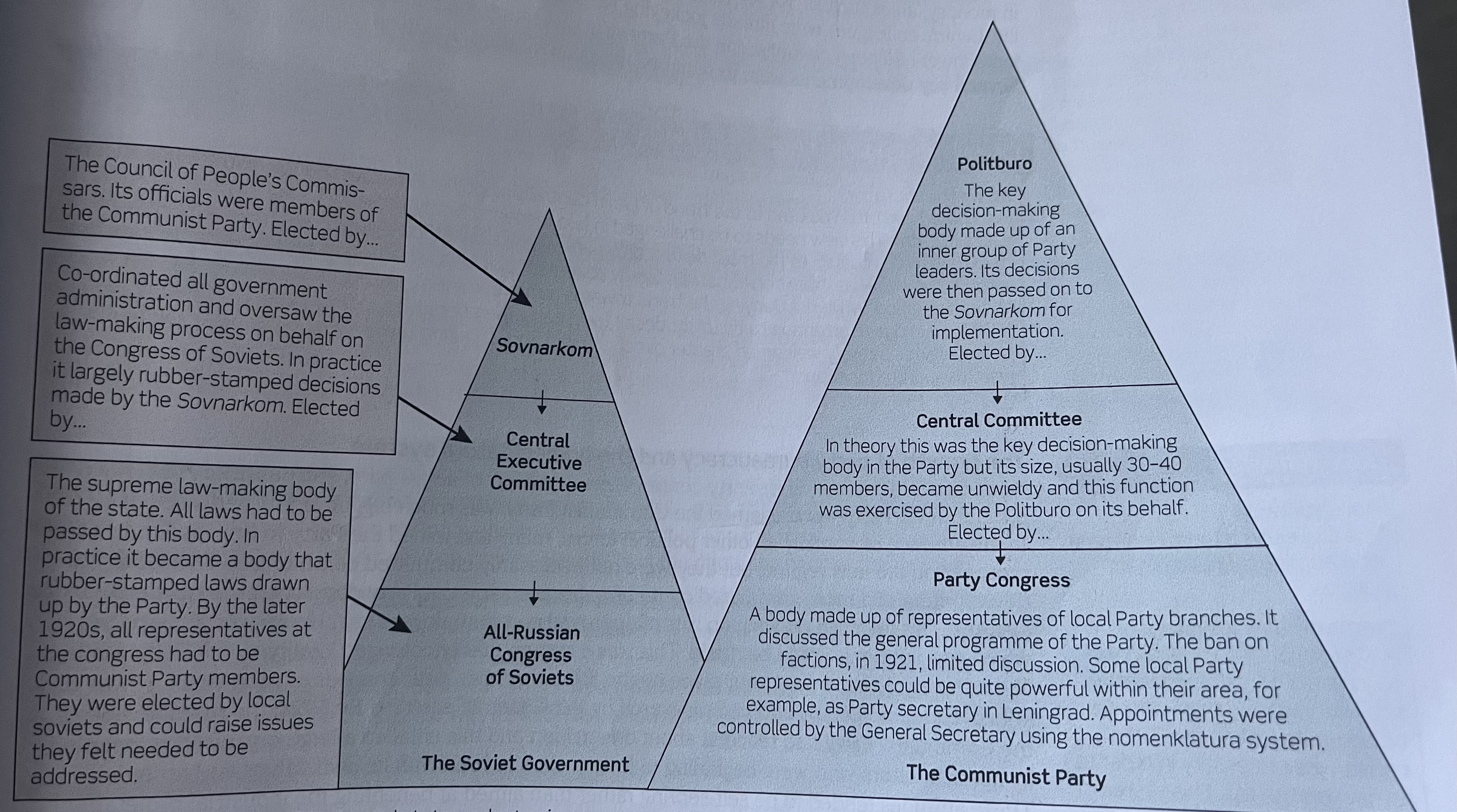the mature of government under Lenin
1/11
There's no tags or description
Looks like no tags are added yet.
Name | Mastery | Learn | Test | Matching | Spaced |
|---|
No study sessions yet.
12 Terms
The apparatus of government: Lenin’s reason for changing the apparatus
The machinery of government administration had fallen into chaos before the Bolsheviks came to power
Lenin needed to put in place a state administration that better suited his own revolutionary purposes
Governing a country the size of Russia would require a clear line of authority whereby decisions could be made and imposed on the country effectively and quickly.
overall change
Organisations that genuinely represented the proletariat, such as the soviets, trade unions and factory committees, were brought under Bolshevik control and then sidelined. A system was devised based on representative bodies that in theory stemmed from the All-Russian Congress of Soviets and was headed by the Sovnarkom.
The Sovnarkom
the Council of People's Commissars and took the role of a cabinet of top government ministers who were, in theory, responsible for making key decisions and giving goverment orders. Its members, about 20 in total, were elected by the Central Executive Committee. It was a small group that could make quick decisions and it met on a daily basis during the civil war.
the central executive committee
a larger group elected by the Congress of Soviets.
Its task was to oversee the work of the government and its administration.
All-Russian Congress of Soviets
the supreme law-making body of the state.
All laws issued by the Sovnarkom had to be approved by the Congress. It was, in theory, a highly representative body made up of members elected by local soviets, all those citizens engaged in
'useful work'
Below the main structure
provincial and city soviets made up of representatives from local soviets
These bodies conducted the administration of government at local level
This system of government apparatus was, in principle, very democratic, but the reality was different
During the chaotic situation of the civil war, the Bolsheviks used their control over positions in the Sovnarkom to issue orders that were merely rubber-stamped by the Congress of Soviets and therefore imposed on the country
Party control over the state: politburo
The Politburo was a group of seven to nine leading members of the Bolshevik Party, who were chosen by the Party's Central Committee to make the key decisions affecting policy. It took over from the larger Central Committee, which quickly proved to be unmanageable when making important decisions. The Politburo met daily under Lenin and became more important than the Sovnarkom. Besides Lenin, leading members included Grigory Zinonviev, Lev Kamenev, Leon Trotsky and Josef Stalin
Party control over the state: the central committee
The Central Committee was a group of 30-40 members chosen by the Party Congress to represent its members. The Central Committee was supposed to make key decisions on policy but, after 1919, power was increasingly delegated to the Politburo.
Party control over the state: the party congress
The Party Congress was a body made up of representatives of local Party branches. It discussed the general programme of the Party and there were fierce debates at the Ninth and Tenth Party Congresses of 1920 and 1921. The ban on factions under the ruling On Party Unity, which was passed in 1921, stifled debate, and the role of the Congress in influencing policy subsequently declined. It met yearly under Lenin from 1917 and this pattern continued until 1926.
Party control over the state: Below the level of Congress
Below the level of Congress were local Party branches, each headed by a Party secretary
These secretaries could be very powerful, especially those who headed branches in key cities or provinces
Kamenev was head of the Party in Petrograd and Zinoviev in Moscow; both had significant power bases that allowed them to play an important part in the struggle to succeed Lenin
Thus, the Party organisations mirrored those of the state
Yet it was the Party structure that controlled decision-making, while the state became little more than an organisation of administrators
The decline of the state was indicated by the increasing infrequency of meetings of the Congress of Soviets, Central Executive Committee and the Sovnarkom
When leading Bolsheviks were members of both the Politburo and the Sovnarkom, they sent their deputies to the latter
Another sign of the relative power of state and Party was the decision in 1919 to make the secret police directly responsible to the Politburo rather than the Sovnarkom
Democratic centralism
Soviets were used as bodies that represented the workers at local level
Their wishes could be expressed through a structure of representative organisations that would take their concerns to decision-making bodies at the higher levels of government
Decisions could then be made in the interests of 'the people' and passed down to regional and local level for implementation
This principle was used by the Bolsheviks, and most other communist regimes, as evidence of their highly democratic nature
The reality was different. The soviets had been undermined as soon as the Bolsheviks took power
The system of ruling by decree meant that they were not involved in decision-making
Although the soviets continued to exist they were dominated by the Bolsheviks, who ensured that they were no longer responsive to pressure from the workers they were supposed to represent
Local soviets were used as part of local government, but they were firmly in the hands of local Party bosses who gave the orders
This system turned representative bodies into rubber-stamping bodies that merely carried out orders given by the centre
The structures of party and state under Lenin
